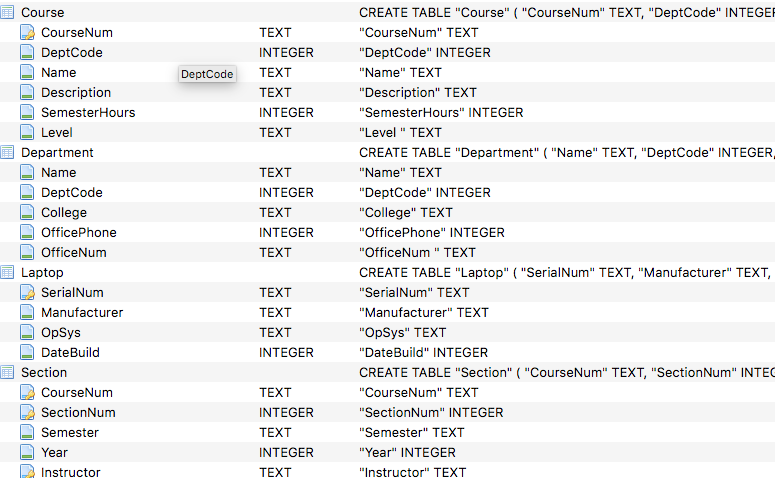

Note: Don't put space between sqlite> prompt and dot command, otherwise it will not work. show command to see default setting of for your SQLite command prompt. Try opening locked tables for ms milliseconds :0) sqlite Share Follow asked at 15:34 Mr. I'm just learning SQL, so forgive my ignorance. db SELECT FROM world.db None of them worked.
#SQLITE LIST TABLES HOW TO#
List names of tables matching a like pattern I can't seem to find documentation (that I understand) on how to list all tables in a database. Show the current values for various settings if table specified, only show tables matching like pattern table.Ĭhange separator used by output mode and. separator stringtabs: tab-separated values Insert: sql insert statements for tableline: one value per line
#SQLITE LIST TABLES CODE#
Set output mode where mode is one of:csv:comma-separated values Ĭolumn: left-aligned columns.html: html code if table specified, only show indices for tables matching like pattern table. Turn output mode suitable for explain on or off. if table specified, only dump tables matching like pattern table. List names and files of attached databasesĭump the database in an sql text format.

See these commands with description in the following table: Commands The above are the list of various important SQLite dot commands. These commands are not terminated by a semicolon ( ).Ĭheck the list of dot commands by using the ".help" at anytime. To show tables in a database using the sqlite command-line shell program, you follow these steps: First, open the database that you want to show the tables: sqlite3 c:\sqlite\db\chinook.db Code language: SQL (Structured Query Language) (sql) The above statement opened the database named chinook.db that locates in the c:\sqlite\db directory. SQLite dot Commandįollowing is a list of SQLite dot commands. used by the SQLite list output mode and by the SQLite dot command. SELECT: This command is used to retrieve certain records from one or more table. A complete SQL database with multiple tables, indices, triggers, and views. Dump the database in an SQL text format If TABLE specified, only dump tables matching LIKE. UPDATE: It is used to modify the records.ĭELETE: It is used to delete records. DB Show status information about the database. INSERT: This command is used to create a record. There are three commands in data manipulation language group: There are three types of SQLite commands:ĬREATE: This command is used to create a table, a view of a table or other object in the database.ĪLTER: It is used to modify an existing database object like a table.ĭROP: The DROP command is used to delete an entire table, a view of a table or other object in the database. The master table holds the key information about your database tables and it is called sqlite_master.SQLite commands are similar to SQL commands. The above setting will produce the output in the following format. You can use the following sequence of dot commands to format your output.

Make sure there is no space in between sqlite> prompt and dot command, otherwise it will not work. show command to see default setting for your SQLite command prompt. Try opening locked tables for MS milliseconds List names of tables matching a LIKE pattern If TABLE specified, only show tables matching LIKE pattern TABLEĬhange separator used by output mode and. If TABLE specified, only show indices for tables matching LIKE pattern TABLE Turn output mode suitable for EXPLAIN on or off. If TABLE specified, only dump tables matching LIKE pattern TABLE
#SQLITE LIST TABLES UPDATE#
Update Dec 2021: Since writing this article, SQLite has. The second method gives you the option of returning both tables and views, or just tables, but only for the primary database. tables Command The easiest way to return a list of tables when using the SQLite command line shell is to use the. The first method returns all tables and views for all attached databases. List names and files of attached databasesĭump the database in an SQL text format. Here are two ways to return a list of tables in all attached databases in SQLite. The above command will display a list of various important SQLite dot commands, which are listed in the following table. Let's start with typing a simple sqlite3 command at command prompt which will provide you with SQLite command prompt where you will issue various SQLite commands.įor a listing of the available dot commands, you can enter ".help" any time. These commands are called SQLite dot commands and exception with these commands is that they should not be terminated by a semi-colon ( ). This chapter will take you through simple and useful commands used by SQLite programmers.


 0 kommentar(er)
0 kommentar(er)
